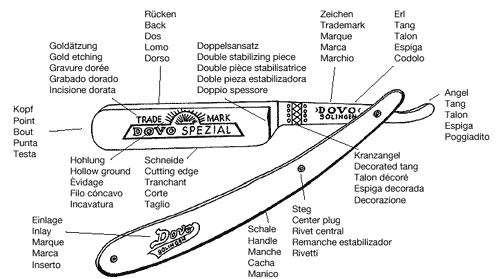Difference between revisions of "The straight razor"
m (Added stuff from http://www.straightrazorplace.com/forums/downloads//ec_tmp/Razor%20Anatomy.pdf) |
|||
| Line 2: | Line 2: | ||
==Basic Straight Razor Anatomy== | ==Basic Straight Razor Anatomy== | ||
| + | [[Image:Straight Razor-Basic Anatomy.png|center]] | ||
| + | Orientation used in the description: the handle to the right, blade to the left, cutting edge pointing downwards. | ||
| + | |||
| + | ; Kopf/Point/Bout/Punta: the left end of the blade. | ||
| + | ; Blade, with a Ruecken/Back/Dos/Lomo: the part of the blade opposite the cutting edge, and an Schneide/Cutting edge/Tranchant/Corte (pointing downwards). | ||
| + | ; Erl/Tang/talon/Espiga: the complete non-cutting metal part fixed to the blade, serving as a grip for the index, middle, ring, and little finger. | ||
| + | ; Doppelansatz/Double stabilizing piece/Double piece stabilisatrice/Doble pieza estabilizadora: two close parallel vertical rims situated where the tang continues to the cutting part on the knife. Sometimes there is only one stabilizing piece. | ||
| + | ; Kranzangel/Decorated tang/Talon decore/Espiga decorada: some sort of art where the blade stops and the tang begin. | ||
| + | ; Schale/Handle/Manche/Cacha: the part of the razor that contains the blade when closed. Sometimes it has an Einlage/Inlay/Marque/Marca (text, mark on the handle). | ||
| + | ; Steg/Center plug/Rivet central/Remanche estabilizador: the middle plug on the handle; Hohlung/Hollow ground/Evidage/Filo Concavo: the biconcave form of the blade in transection view. | ||
| + | ; Goldaetzung/Gold etching/Gravure doree/Grabado Dorado: the mark or text on the blade. | ||
| + | ; Zeichen/Trade mark/Marque/Marca: the mark/text graved on the tang. | ||
| + | ; The Ridge/Der Wall: parallel to the back and the edge, running from point to the stabilizing piece, is a thickening of the blade, the purpose of which is to stabilize against torsion in the horizontal plane, and to give the edge elasticity. The stabilizing piece gives the blade torsion resistance in the vertical plane. If the ridge is close to the edge, it is called =BC hollow ground, the lowest grade of hollow ground; if it is close to the back, it is called 1/1 or full hollow ground; =BD and =BE are in-between. | ||
==Straight Razor Point Styles== | ==Straight Razor Point Styles== | ||
==Widths and Grinds== | ==Widths and Grinds== | ||
| + | |||
| + | |||
==Scale Materials== | ==Scale Materials== | ||
Revision as of 01:34, 15 October 2008
In this entry, we will explore straight razors a bit more in depth including the anatomy of a straight razor, different styles of razors, things to look for when buying antique straight razors for use, questions to ask a seller when purchasing an antique razor online, as well as many other things.
Contents
Basic Straight Razor Anatomy
Orientation used in the description: the handle to the right, blade to the left, cutting edge pointing downwards.
- Kopf/Point/Bout/Punta
- the left end of the blade.
- Blade, with a Ruecken/Back/Dos/Lomo
- the part of the blade opposite the cutting edge, and an Schneide/Cutting edge/Tranchant/Corte (pointing downwards).
- Erl/Tang/talon/Espiga
- the complete non-cutting metal part fixed to the blade, serving as a grip for the index, middle, ring, and little finger.
- Doppelansatz/Double stabilizing piece/Double piece stabilisatrice/Doble pieza estabilizadora
- two close parallel vertical rims situated where the tang continues to the cutting part on the knife. Sometimes there is only one stabilizing piece.
- Kranzangel/Decorated tang/Talon decore/Espiga decorada
- some sort of art where the blade stops and the tang begin.
- Schale/Handle/Manche/Cacha
- the part of the razor that contains the blade when closed. Sometimes it has an Einlage/Inlay/Marque/Marca (text, mark on the handle).
- Steg/Center plug/Rivet central/Remanche estabilizador
- the middle plug on the handle; Hohlung/Hollow ground/Evidage/Filo Concavo: the biconcave form of the blade in transection view.
- Goldaetzung/Gold etching/Gravure doree/Grabado Dorado
- the mark or text on the blade.
- Zeichen/Trade mark/Marque/Marca
- the mark/text graved on the tang.
- The Ridge/Der Wall
- parallel to the back and the edge, running from point to the stabilizing piece, is a thickening of the blade, the purpose of which is to stabilize against torsion in the horizontal plane, and to give the edge elasticity. The stabilizing piece gives the blade torsion resistance in the vertical plane. If the ridge is close to the edge, it is called =BC hollow ground, the lowest grade of hollow ground; if it is close to the back, it is called 1/1 or full hollow ground; =BD and =BE are in-between.
Straight Razor Point Styles
Widths and Grinds
Scale Materials
Buying Razors
Bevel Condition
Reading Hone Wear
Pitting
Serious Issues
Frowning Blades
Edge damage
Heavy Pitting
Extreme Warping
Questions to Ask A Seller
- When was the blade last honed?
- Does it center in the scales without the edge making contact on either side?
- Is the pivot pin tight?
- Are the scales original?
- Are there any cracks in the scales?
- Are there any hairline cracks in the blade?
- Do you have pictures of the (other side of the blade, close up of a certain area, etc)?
- Do you offer a return policy if I am not satisfied?
- If yes, what are the terms?
